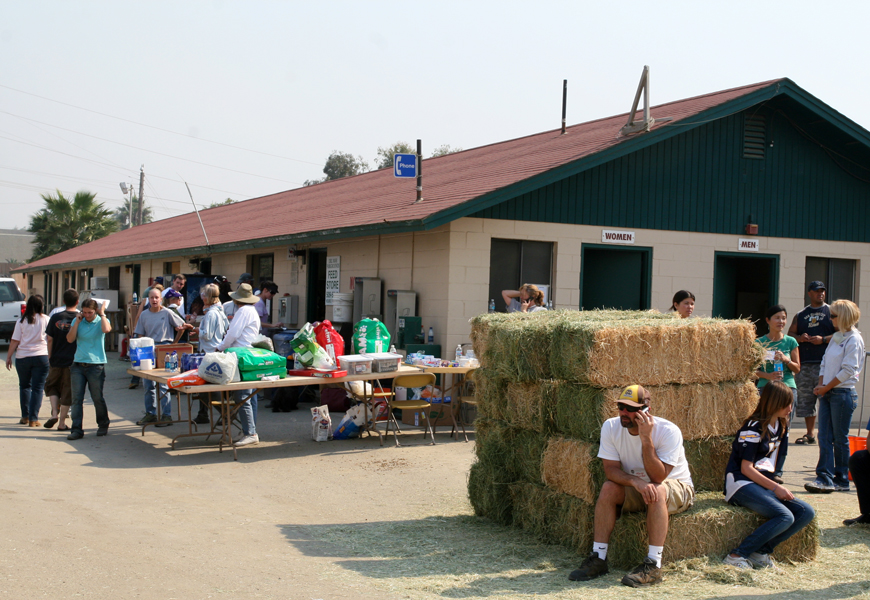With the recent natural disasters in California due to fires and mud slides, horse owners need to have an evacuation plan. Things happen quickly, as we saw with the recent fires in San Diego that claimed the lives of 45 race horses. Not to mention the lives lost in the Santa Barbara area. Though any loss of life, whether it’s a human or animal is a tragedy, a sound rescue plan needs to be thought out before an actual emergency happens.
Every region in the USA has different challenges to consider when putting an emergency response plan together. For example, California is most likely to experience wild fires, mud slides and earthquakes. Florida would need to focus on fires and hurricane response plans.
Here are some important steps to consider in establishing a disaster and emergency plan for horses:

Transportation:
It’s always a good idea to have at least a half a tank of gas in one’s automobile – always. In a disaster, you might not have the time to run to the gas station. If you have trucks at your stable, make sure they all have at least half a tank of gas in them.
Be sure horse trailers are in shape to be used on a moment’s notice. Check that the tires and brake lights are in working order.
Identification:
Each horse should be identified with at least one, if not all of the following:
- A leather halter with name/farm information in a zip lock bag secured to the halter with duct tape.
- A luggage tag with the horse/farm name and phone number braided into tail. (Make sure this is water proof).
- Photos of each horse as proof of ownership highlighting obvious identifying marks.
Keep several copies of photos of the horses you are responsible for. Keep them in your automobile, next to your horse’s stall, etc.
Water:
Dehydration is a major cause of death for horses in disasters of all kinds. Storm runoff may contaminate natural water supplies; power failures may knock out your well pump, and even municipal water supplies may be interrupted. It’s always a good idea to have jugs of water available if you need to load up the horse trailer and get the horses out of harms way.
- Figure on 12 to 20 gallons per horse per day, and have at least a three-day supply (seven is better) on hand.
- Store water in clean 55-gallon drums, and fill all troughs and other containers on the property. Line garbage cans with plastic trash bags and fill them, too.
- Have chlorine bleach on hand to purify water if necessary. Add two drops of bleach per quart of water and let stand for 30 minutes.
Disaster kit:
Keep these supplies within easy reach. During an emergency, the last thing you want to do is to be running around gathering all these items. Have 1 location for all your emergency supplies.
- Flashlight and batteries
- Battery-operated radio
- First-aid supplies for both horses and humans
- Extra halters (leather or breakaway) and lead ropes (with stud chains for extra control)
- Clean towels
- Emergency tools—chain saw, hammer and nails, wire cutters, pry bar—and, of course, duct tape
- Materials for quick temporary fence repairs
- Fire extinguisher
- List of emergency contacts, including your veterinarian and state and county animal-welfare and emergency-response teams.
Know where to go:
All stables should have a posted notice on where to go and at least 2 escape routes during an emergency. Where and how far you travel will depend on the threat. If a rising river floods your property, safety may be just up the hill at your neighbor’s barn. If it’s a major hurricane or fire, you’ll need to travel farther. Have several options, in different directions, for different scenarios.
Leave early:
Get on the road as soon as possible before approaching flames or rising floodwaters cut off your escape route. Two or three days before a hurricane is not too soon. If the storm changes course and spares your farm, you can consider your trip a drill. Waiting could mean being caught in traffic jams (as happened outside Houston before Hurricane Rita last year) or in winds strong enough to flip a trailer.
Arrange stabling:
Network to figure out where you can take your horses, or contact local horse and animal-welfare groups. Florida has a searchable database of facilities that can take in horses in emergencies (online at www.sshc.org/evac). San Diego Humane Society helped set up large-animal shelters at Del Mar and other sites during the recent fires.
Additional National Resources:
FEMA
National Hurricane Center
United States Animal Health Offices (State Veterinarians)
Canadian Animal Health Offices (Provincial Veterinarians)
Ready America
AVMA (Disaster Preparedness Info for Veterinarians)
USDA Resources:
USDA Animal Health Emergency Management
National Center for Animal Health Emergency Management
The American Association of Equine Practitioners (AAEP) (www.aaep.org)
The best moto to have is “Hope for the Best. Prepare for the Worst”.
By Kathy Klossner – Kathy has been involved with horses before she could walk. Having owned several horses through the years and showing in both English and Western Pleasure classes, Kathy now dedicates her time to helping horse rescue organizations in getting more exposure on the Internet for funding and recruiting volunteers. She is also involved with several Wild Mustang horse advocate groups in keeping our wild horses free.
